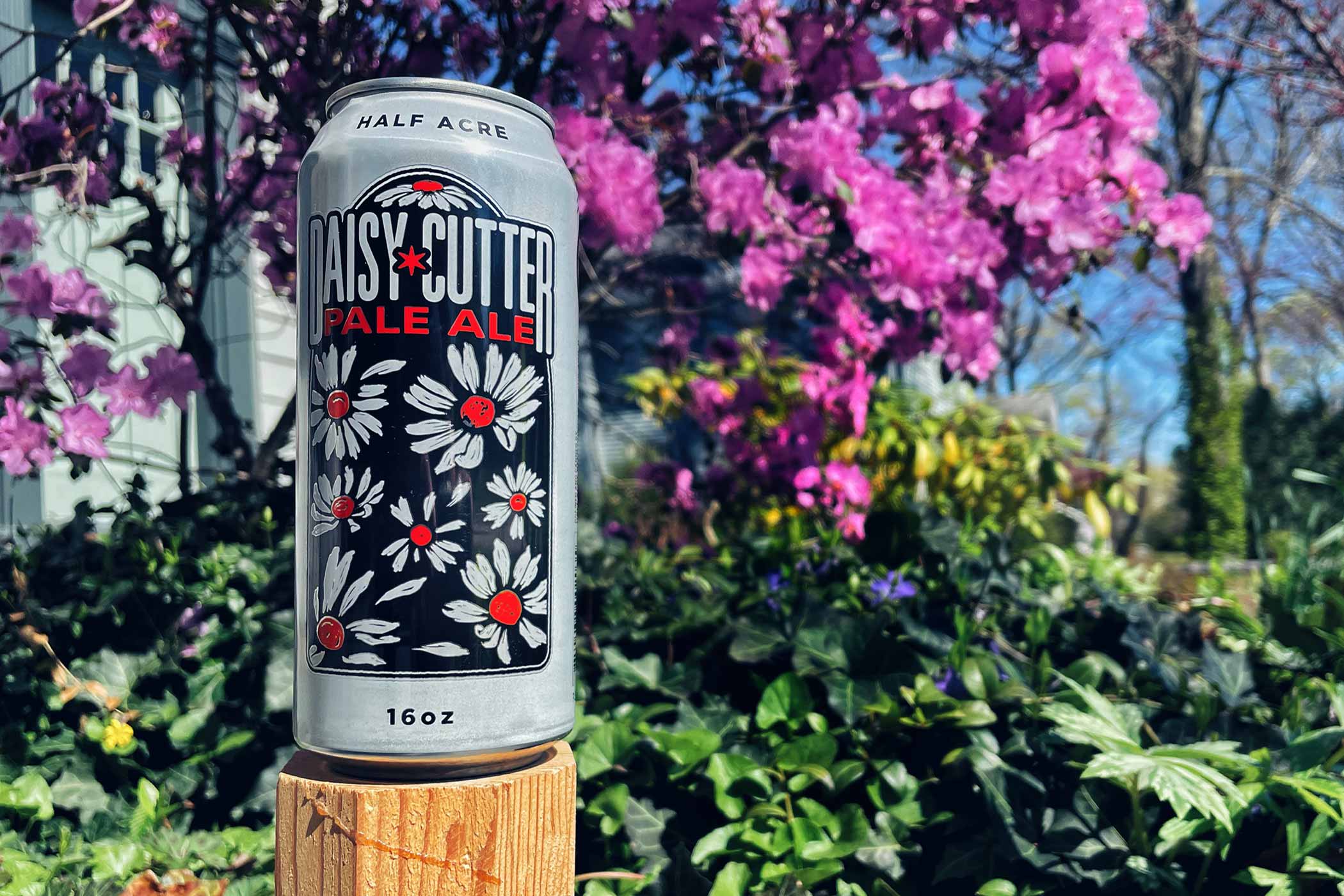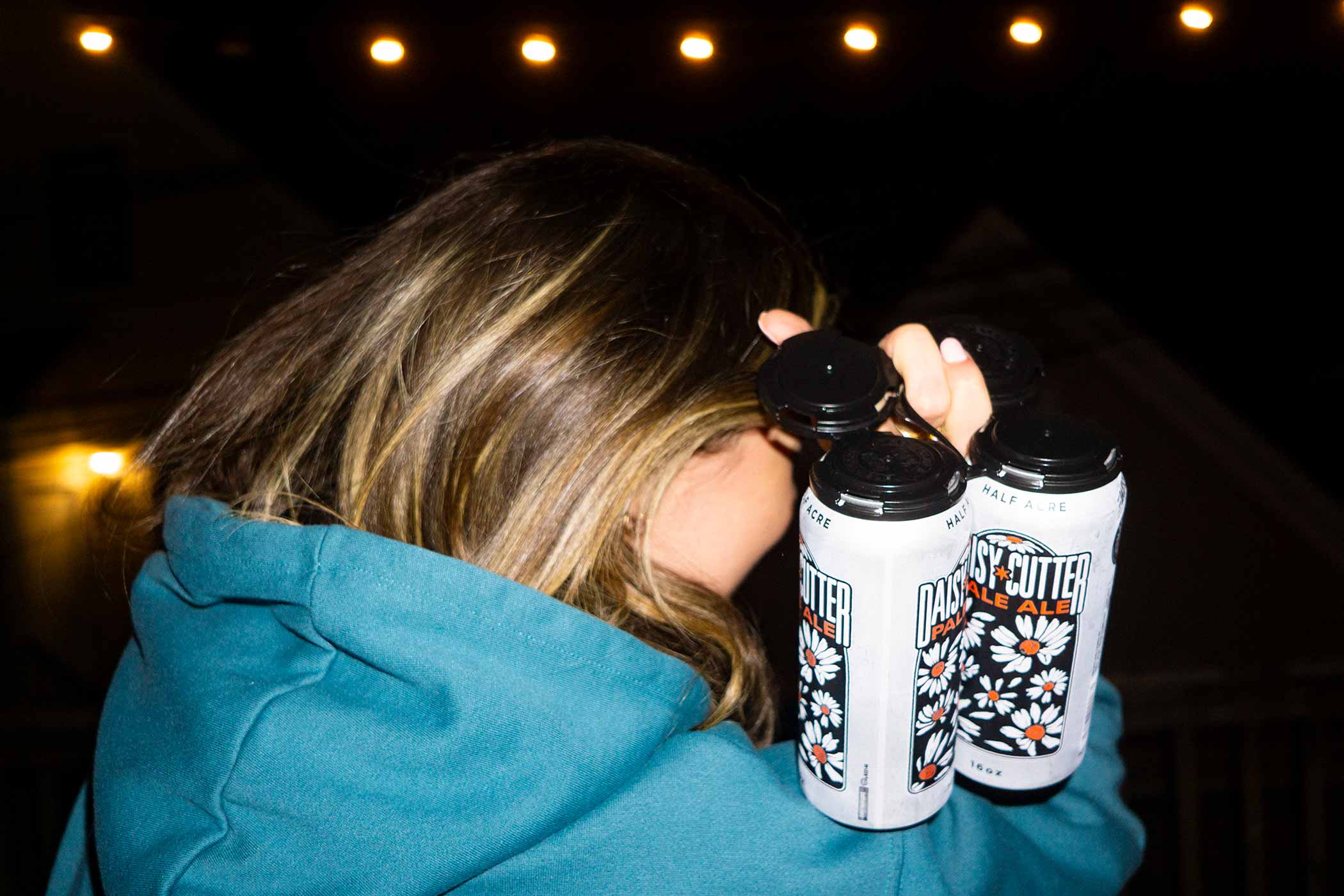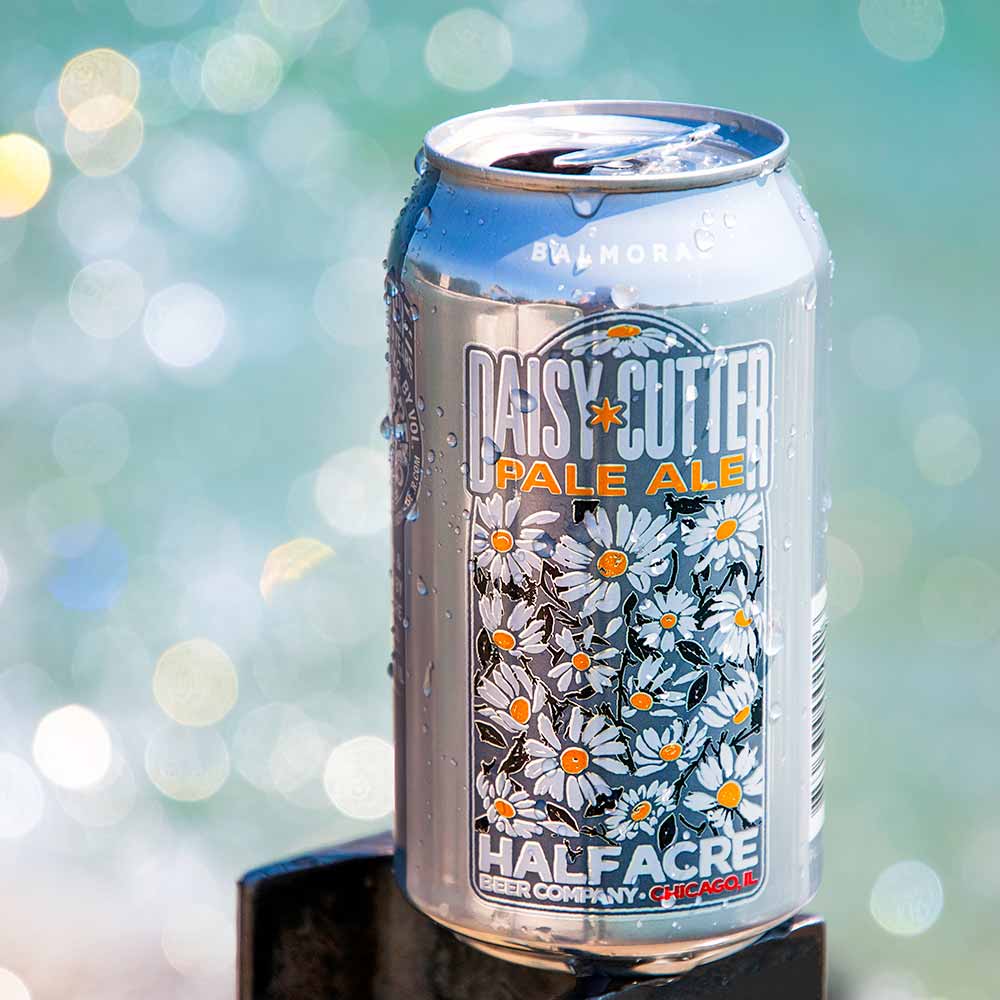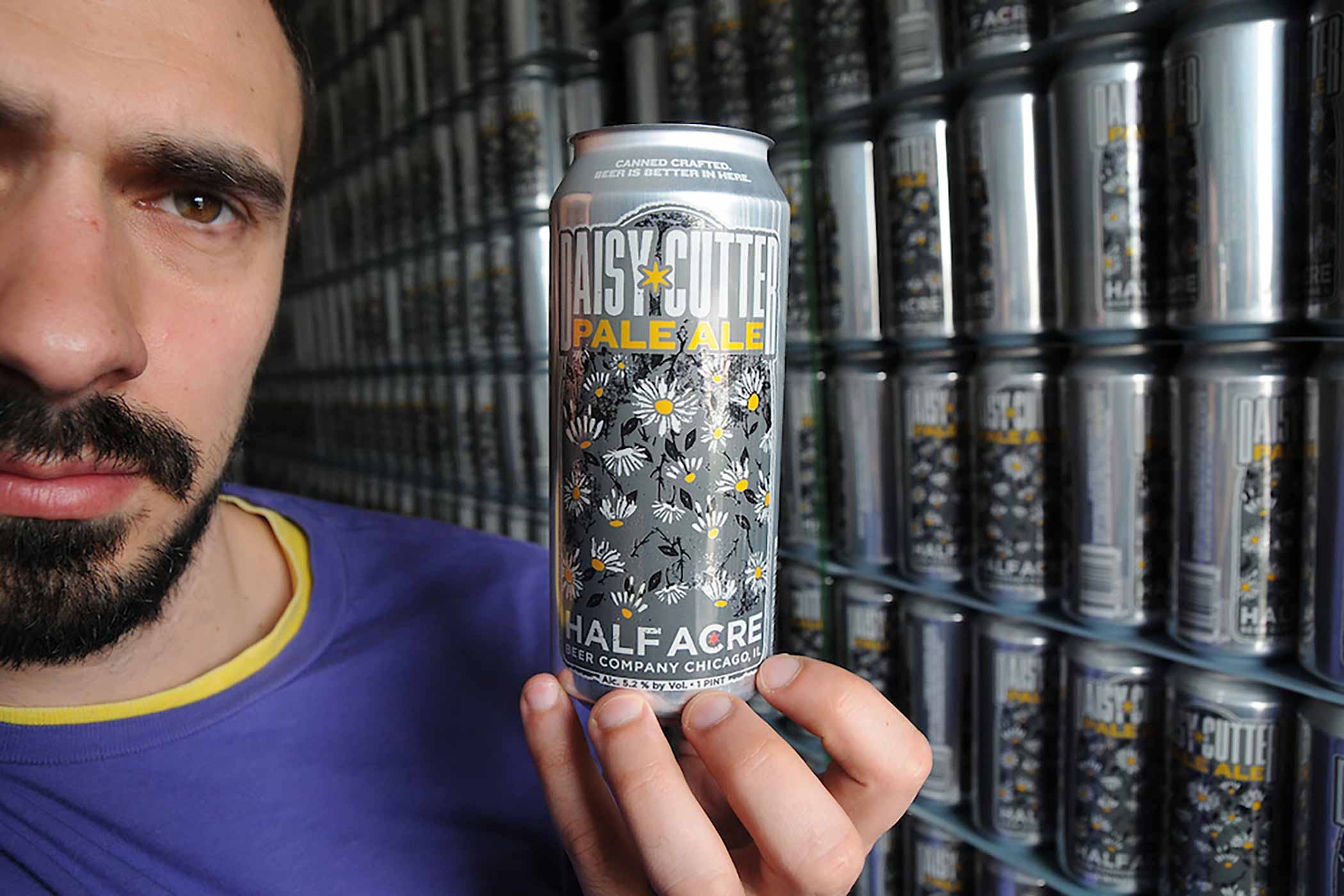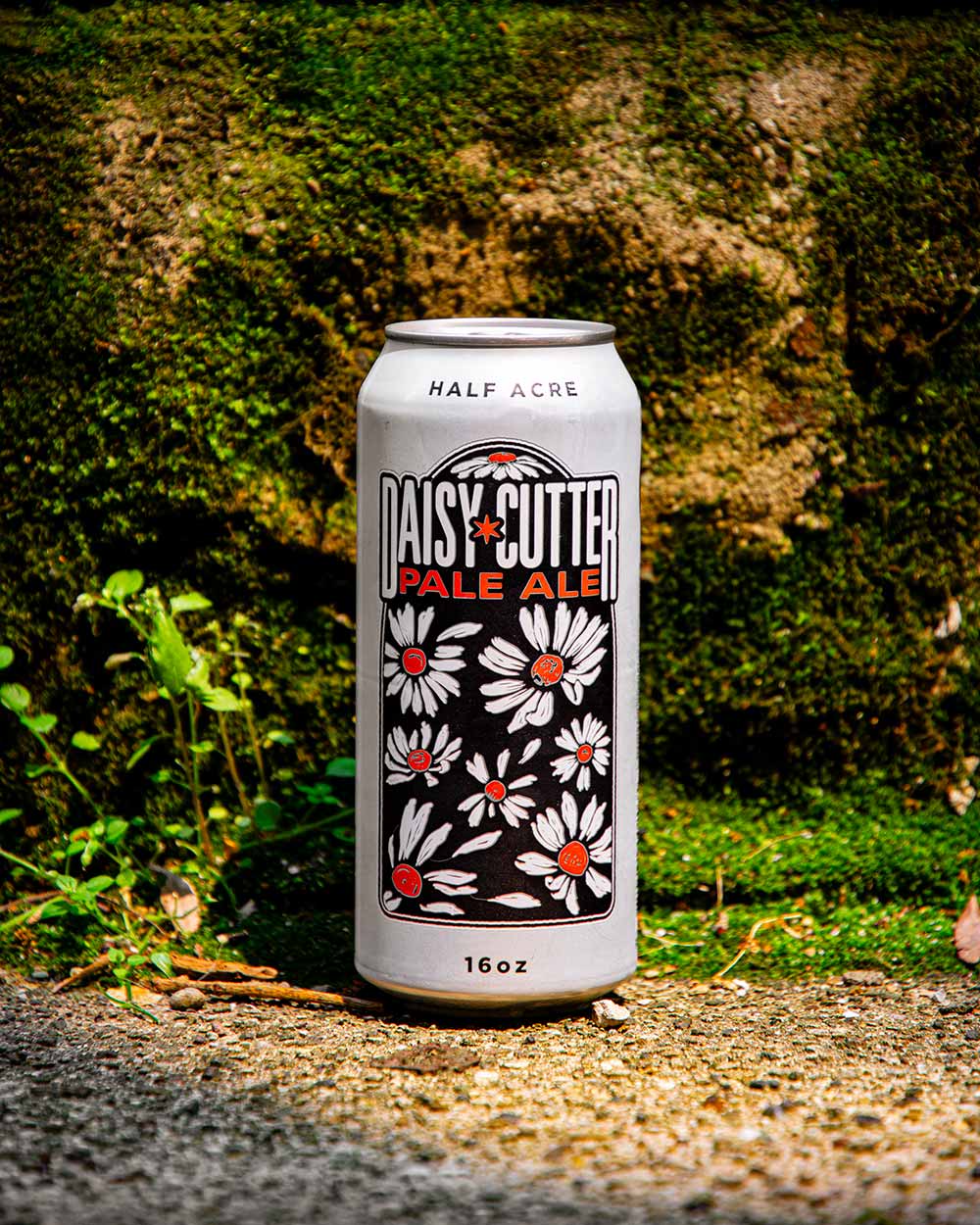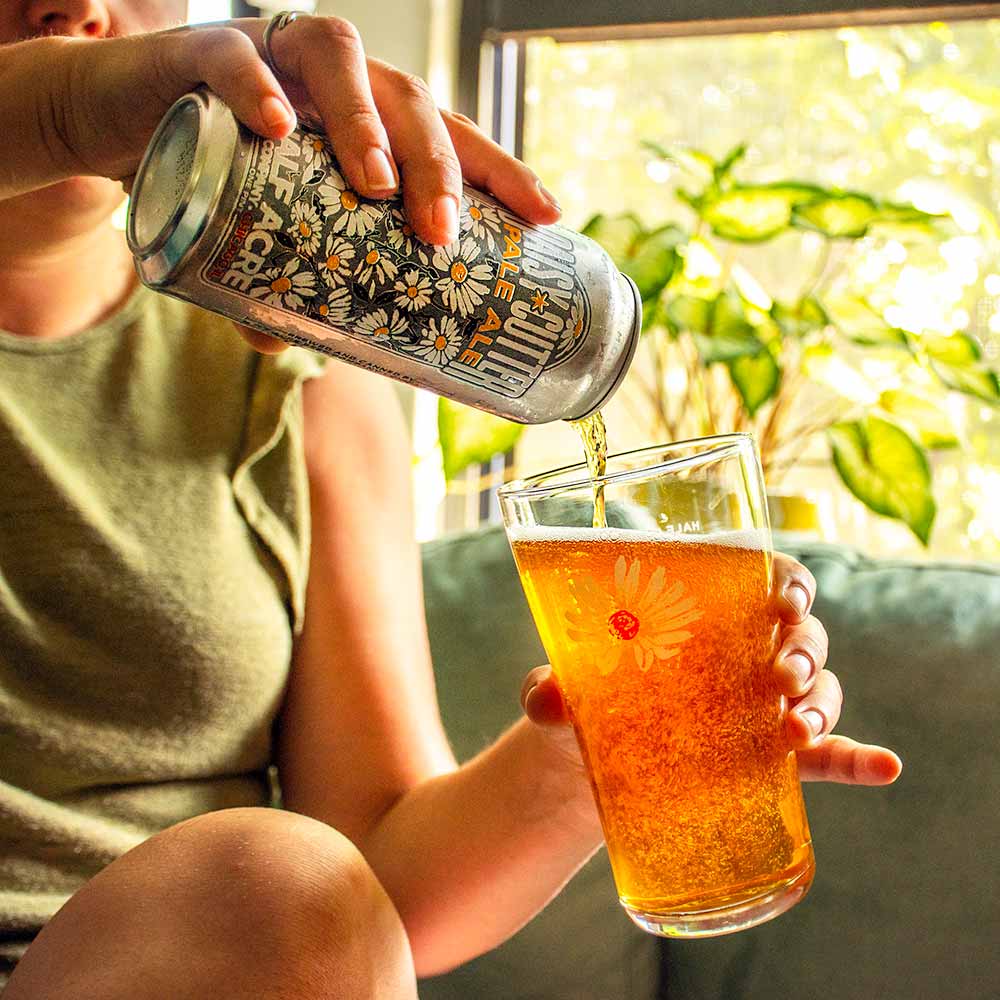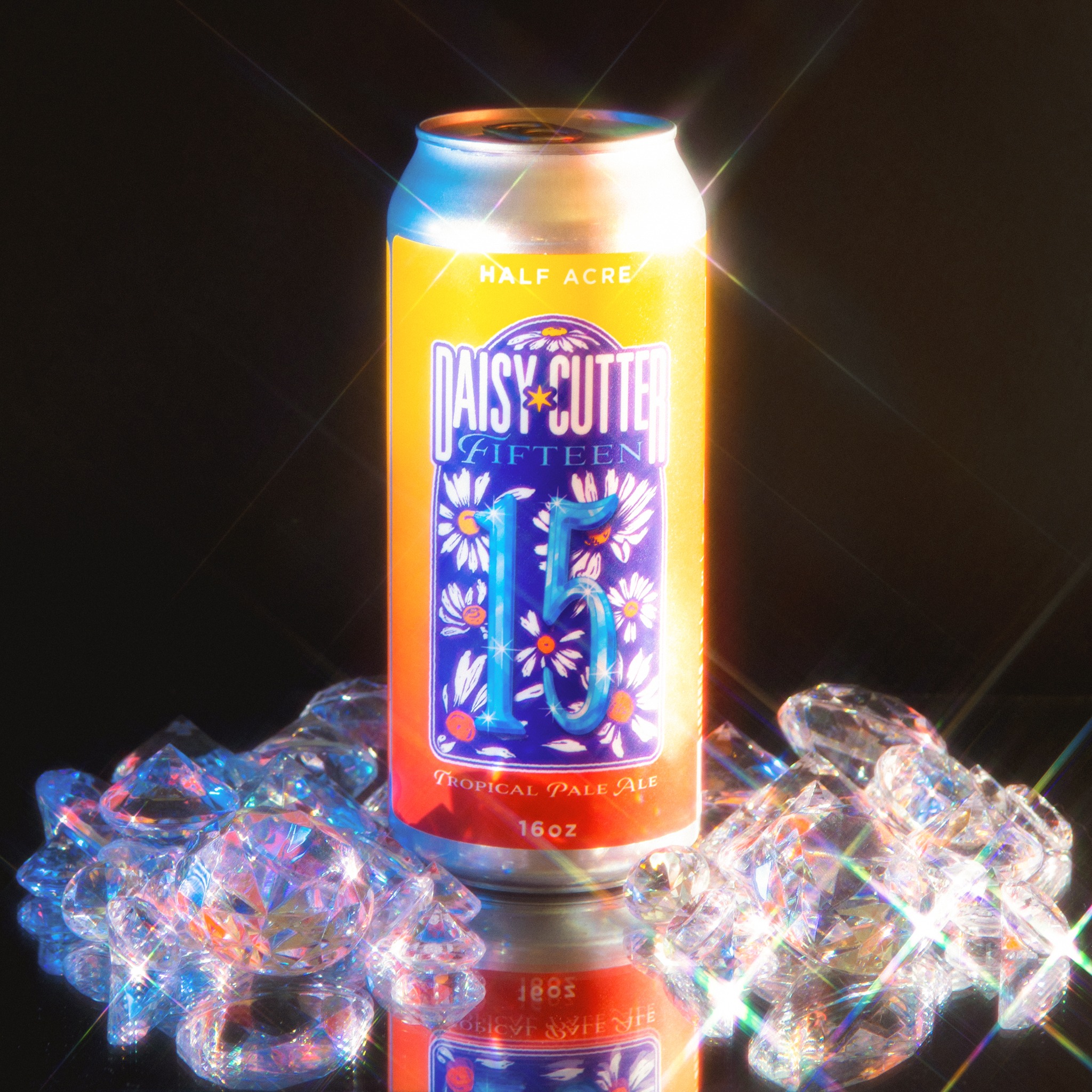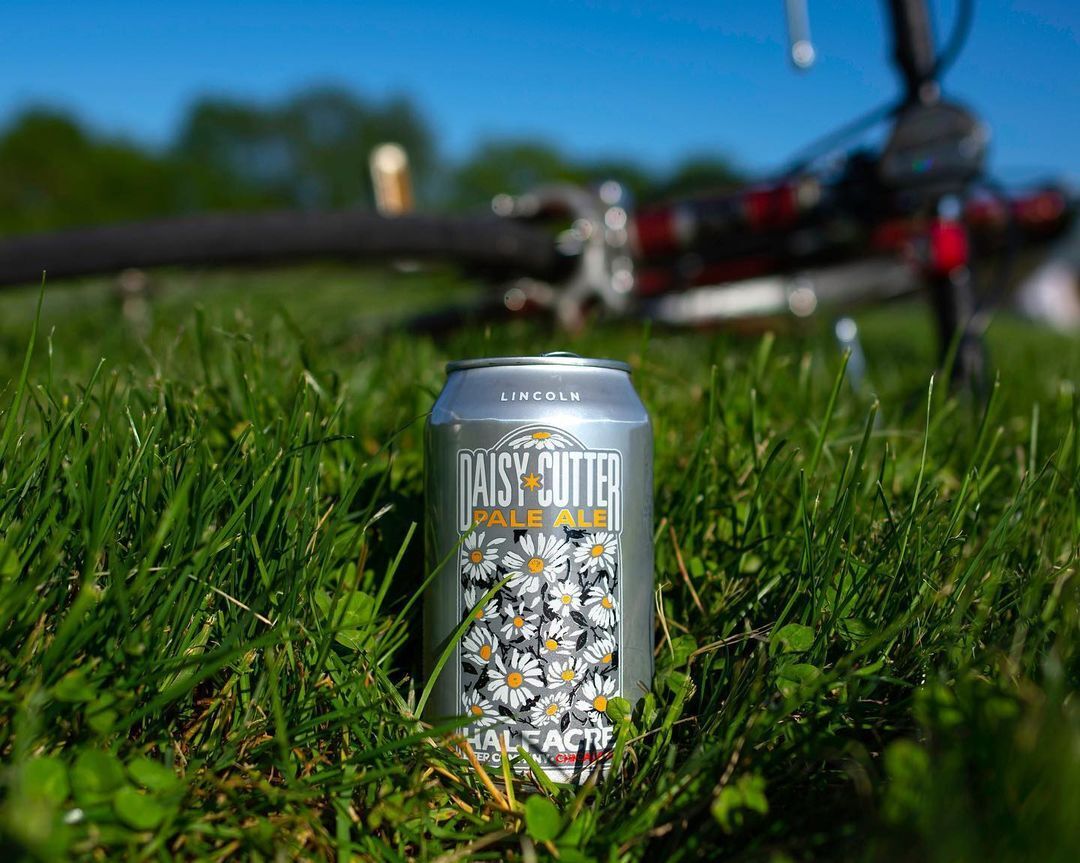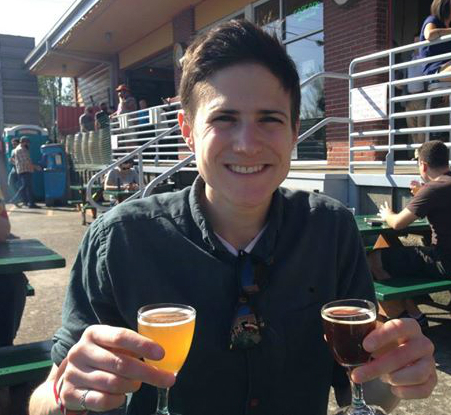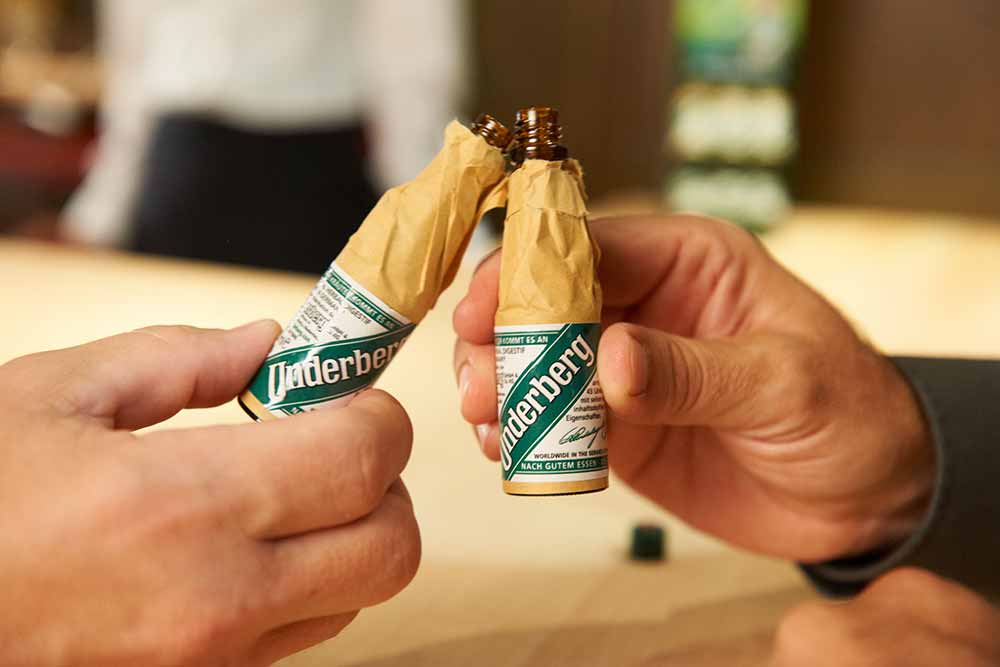Shop
9 Things You Didn’t Know About Half Acre’s Daisy Cutter
The beer that will never be pushing daisies.
Looking for More Like This?
“I’ll take a Daisy.” Half Acre Beer Co. Co-Founder Gabriel Magliaro can’t tell you how many hundreds of times he’s heard that refrain when someone orders the Chicago-based brewery’s iconic Daisy Cutter pale ale. And every single time, it makes him smile. “When they ‘cut’ it in half, when I hear it like that, I know that beer has become a part of their life,” he says proudly.
When you give something a nickname, you make it your own; you feel you own it, right? You’ve said it so often that it’s become a natural part of your life. Like shortening Coca-Cola to Coke or Narragansett to “Have a ‘Gansett.” You’re in the neighborhood of good company.
And Daisy Cutter has undoubtedly become a beer with a life all its own, up there in the pantheon of the most iconic beers in American craft beer.
For Chicagoans, certainly. But also for drinkers all across the country.
With Daisy Cutter celebrating its fifteenth anniversary this year, we sat down with Magliaro, Half Acre Director of Brewing Operations Matt Young, and Hopleaf Publican and Owner Michael Roper, one of the first to carry and support Daisy Cutter, to discover just where Half Acre got the idea for this pale ale, why the beer is actually named after a bomb, and how this beer blew up across craft beer.
Daisy Cutter Wasn’t the First in the Room, But It Will Probably Be the Last
Daisy Cutter wasn’t Half Acre’s first beer. The Chicago-based brewery started in 2007, brewing its beers nomadically out of Sand Creek Brewing Co. and sticking to what Magliaro calls “responsible commercial choices.” Those like Over Ale brown ale.
When they finally moved into their now-legendary spot on Lincoln Ave in 2008, Half Acre’s psychology shifted.
“Let’s not worry so much about what might do well or what the industry realities are,” he remembers. “Let’s just make things that make sense to us as people who love drinking beer and people who are inspired to be around beer.”
Even at their brick-and-mortar, Daisy Cutter wasn’t the first beer they brewed.
It was the second.
But the Half Acre Co-Founder recalls the beer blew him away right from the beginning. “I remember being very excited to drink it and share it with people,” says Magliaro, who often poured makeshift growlers for people in the brewery’s Lincoln Ave retail shop. “The whole room smelled like Daisy Cutter; I felt very, very pumped about it.”
In fact, many, many people felt very, very pumped about it right from the drop.
Daisy Cutter, Right Place, Right Time
Daisy Cutter debuted on April 29th, 2009.
Literally the equivalent of a booming microphone drop, the pale ale’s impact was felt instantly.
A big bang of sorts, Daisy Cutter dropped at just the right time, in just the right conditions.
Take your mind back to Chicago fifteen years ago.
The landscape looked so different. You could name the significant breweries on one hand: Goose Island, Piece Brewery, Two Brothers Brewing Company (out in the ‘burbs), and Rock Bottom.
One could argue that more people knew the city more for its craft beer bars—like Hopleaf—and the Siebel Institute.
“Chicago had an outsized beer presence without having a lot of breweries,” Magliaro remembers. “It was a good beer town that was clearly ready for more.”
At that moment, only 1,500 breweries existed in the entire country compared to the over 9,500 currently.
Pioneers such as Ken Grossman with Sierra Nevada Pale Ale, Rob Tod with Allagash White, and Jim Koch with Boston Lager had planted seeds for the last two-plus decades.
The soil was rich and its fruits ripe for the picking.
Into this growing garden, Daisy Cutter bloomed.
Young, who has brewed Daisy Cutter for the last fourteen years, puts it simply: “It was the right place at the right time.”
People weren’t drinking overly hoppy beers; hazy IPAs didn’t entirely exist yet, and “craft” was starting to snowball.
Daisy Cutter filled a need—one people didn’t even know they needed.
“There were plenty of hoppy beers that came before Daisy Cutter, no doubt, but they were maltier IPA recipes, a decent amount of sweetness and body, a lot of chewy IPAs in the ‘90s and leading into the early 2000s,” says Magliaro. “Daisy, I think then and now, had one definable characteristic: It was bone dry.”
You took one balanced sip, and you immediately wanted another.
Young actually remembers drinking his first Daisy Cutter at Hopleaf. “When they presented that glass to me across the bar, I could already smell the hoppy aromas,” he remembers. “For that time period, it was such an intense experience with hops and liquid. … There was an amazing opportunity to slot in [Daisy Cutter] as everyone’s go-to beer while on the town in Chicago.”
As someone who brought Daisy Cutter into his bar, Hopleaf Owner Michael Roper saw this pale ale explode firsthand. Hopleaf didn’t carry Half Acre until they settled into a brick-and-mortar location, but since first putting Daisy Cutter on tap fifteen years ago, they’ve continuously poured a Half Acre beer (exclusively Daisy Cutter for a long time, but now could be anything, especially when Half Acre releases something special).
“Their timing to release Daisy Cutter was very fortuitous,” Roper explains, noting that Goose Island was starting to lose its luster and would sell to Anheuser-Busch InBev in 2011. “They beat the big stampede.”
During the current charge, Roper points out that many breweries often ask, “How do we become the next Half Acre? “How do we get that mojo? How do we hit a home run our first time at the plate?”
The answer goes back to the roots.
Daisy Cutter Plants a Flag(ship)
Daisy Cutter quickly became Half Acre’s solid, dependable flagship.
Roper cites this as part of Daisy Cutter’s success. “It was a great loyalty builder,” he says. “If you like good local craft beer and you’re getting married, … you could easily fill ice chests with cans of Daisy Cutter, and you’re going to make a lot of people happy.”
Daisy Cutter wasn’t super shiny. But it was a people pleaser. And that gave it legs.
“A beer like Daisy Cutter, it’s a really come-one, come-all beer,” according to Magliaro.
And, as Roper says, it gave Half Acre the “freedom to fail and the freedom to have a spectacular artistic success.”
Roper says that many breweries today mistakenly forgo a flagship. You create brand buy-in with a steady, reliable flagship. Daisy Cutter couldn’t be a better cookie-cutter example.
“It’s kind of like a film studio that has, like, a blockbuster hit and then hires a twenty-year-old Polish director to do an art movie in Polish,” says Roper. “You know, it’s only going to appeal to a very small audience. But you can do that because you had this blockbuster that earned $3 million.”
Half Acre didn’t set out to make a boundary banger. They didn’t plan on brewing a beer that would grow more like a towering sunflower than a tiny daisy.
They simply wanted to brew a beer they loved to drink.
Combined with a slight tweak to the hoppy ales of the time and the burgeoning industry, that sentiment converged in one cosmic cultivation.
“When Daisy came out, all those things clicked at one time,” explains Magliaro, “and it was palpable. We were pulled into a slipstream of positivity.”
Daisy Cutter Became Controlled Chaos
Whereas some of America’s most iconic beers that came before Daisy Cutter—Allagash White and Sierra Nevada Pale Ale, to name a couple—took a long time to become popular (like a decade-long time), Daisy Cutter hit right away, dropping like a bomb.
Appropriate considering the name Daisy Cutter in part references a type of fuse designed to detonate an aerial bomb. (Magliaro says the name also gives props to a Ween song called “Push th’ Little Daisies,” and alludes to the term ‘hop bombs’ folks often used to describe hoppy beers.)
But Magliaro graciously attributes this seismic boom to the beers that paved the road before.
“There was some groundwork in place,” he says. “Things were bubbling up in Chicago and elsewhere, so it was that right place, right time where Daisy Cutter mirrored the true spike and evolution of craft beer in Chicago.”
Immediately, Half Acre could barely keep up with demand. For the first few years, Magliaro says they even had to stop opening up new accounts. “[Daisy Cutter] yanked us through the woods, and we were doing our best to be mindful caretakers for it,” he says.
Controlled chaos might be the best way to describe it.
“The response was so massive because it was the beer kicking down the doors of the town,” says Magliaro. “We were walking in behind it.”
Roper bluntly says he isn’t sure Half Acre would have been as successful without Daisy Cutter. “The door opener was definitely Daisy Cutter.”
But Magliaro turns around and synergistically emphasizes that Daisy Cutter partially succeeded because of bars like Hopleaf.
“Daisy Cutter was [Roper’s] best-selling beer for a long time,” recalls Magliaro. “And Daisy was popping up all over.”
Roper says he noticed a trend. “If we put a Half Acre neon in the window, then a bar two miles away on Clark Street said, ‘I think I want a Half Acre neon in my window, and I’ll carry Daisy Cutter, too,’” He says.
Over time, people came to know the name Daisy Cutter before that of Half Acre.
“It wasn’t like, ‘What’s that Half Acre beer?’” says Magliaro. “It was like, yeah, the Daisy Cutter, I’ll try that.”
Even today, Magliaro challenges that if you polled a hundred Chicagoans or people from around the country and tested the awareness of Half Acre vs. Daisy Cutter, “I bet Daisy Cutter would get the win,” he says with a smile. “And I bet if you polled people associated with the 9,500 breweries [in the country], Daisy Cutter would have a larger resonance than Half Acre as the name.”
He continues, “And that’s awesome!”
That’s what builds a lasting legacy, hitting a home run over and over and over again.
What causes someone to amble up to the bar and go, “I’ll have a Daisy.”
Half Acre Calls Daisy Cutter A Forever Pale Ale
Yes, on its face, Daisy Cutter is considered a pale ale, but it’s Half Acre’s own version.
“It’s called a pale ale,” says Young. “But pale ale has changed a lot over the years, and … there isn’t a lot out there still doing what Daisy Cutter does flavor-wise.”
It’s what makes Daisy Cutter what the brewery has come to call a “forever pale ale.”
When asked straight up why Daisy Cutter succeeded, Magliaro also points to Daisy Cutter’s Goldilocks halo.
“It’s somewhere right in the middle of how people enjoy beer,” he says. “It has a relative balance between a classic hop profile and that malt profile that is remarkable, … those two components working so nicely in tandem always have a home in the world.”
Drinking a Daisy Cutter does feel like coming home. It’s familiar, comforting, and something we can always come back to when we’ve been away for a long time.
When I drink a Daisy Cutter, it’s like hearing a Backstreet Boys song come on the radio—I know all the words and have absolutely no qualms belting them out in the car. Or it’s like walking inside my front door after a long trip, dropping the luggage, and flopping onto my bed with a contented sigh. There is no other place I want to be in that moment.
Cracking a Daisy Cutter grounds us. All of us.
“Daisy Cutter is a beer that splits the fine line between a beer the hop-crazed will love and the everyday drinker will love,” says Roper.
Young agrees that Daisy Cutter expertly toes that line between hop-forward beer balanced with malt character. You might say it’s the Mister Rogers of beer. “It just sits in a nice, pleasant little pocket where hoppy beer drinkers like it; it’s happy enough for them,” he says, “but people who aren’t really super adventurous with hop-forward beers, it also fits into that pocket.”
He likens Daisy Cutter to “a piece of toasted bread with orange marmalade.”
When you take that first sip, you get both the balance of hops and malt simultaneously. One never overpowers the other. “The hops bring the orange, citrus, piney note, and there is a decent complexity with the malt; it’s like toasted, not roast level, but toasty,” says Young.
As a “forever pale ale,” Daisy Cutter is almost responsible for staying immutable.
“I think our job is not to f**k with that,” Magliaro admits.
Half Acre isn’t looking to make Daisy Cutter better. In fact, the recipe hasn’t changed at all in fifteen years.
It’s now Half Acre’s duty, in a heavy-is-the-head-that-wears-the-crown sort of way, to be custodians of Daisy Cutter.
Daisy Cutter Custodians, Half Acre Has Kept the Recipe Intact for 15 Years
Originally developed by previous Half Acre brewer Tommy Nicely, Daisy Cutter nails that balance between malt and hops.
“The soul of the beer is not just one thing,” explains Young. “It’s the malt, yeast, and hops all working together; they’re all fairly well-balanced.”
To start, Young points out that the grist is pretty unique. Alongside the basic two-row, “We use a decent amount of cool specialty malts from Briess that are real biscuity and bready,” he says. “It’s like a piece of toasted bread flavor from that malt bill.”
On the hop side, Young dug into bankers boxes full of old brew sheets for us to nail down all the details.
The CliffsNotes?
Amarillo and Simcoe have always been the dominant hops on the hot side with supporting hops in the dry hop including CTZ, Centennial, and Chinook, hopped at just under a pound per barrel, according to Young.
To Magliaro’s early point, Daisy Cutter mashes pretty low to “dry the beer out as much as we can so that it finishes really dry and crisp,” says Young.
If a home is just a house until you put people inside it, Young thinks Daisy Cutter is just a recipe until you consider the intangibles making the beer: the souls behind it.
“The recipe is definitely important, but at a certain point, it also takes on a life of its own,” he says.
It’s survived and thrived for fifteen years for a reason, right?
If Daisy Cutter were the spoon held by the kid in the Oracle’s apartment in The Matrix, the world around Daisy Cutter has indeed bent and changed.
But Daisy Cutter itself has, for the most part, stayed the same.
“We’re just trying to keep it the way it’s been,” says Magliaro.
For Young, who has been overseeing that consistency for the last decade and a half, that has sometimes been a challenge.
He thinks of Daisy Cutter in different periods.
When Half Acre moved its production to a new site on Balmoral, Young says they had to fit Daisy Cutter into a new brewhouse setup.
In 2017, to make their operations more sustainable, Half Acre started brewing Daisy Cutter in a high-gravity method, “which means that we make a more concentrated wort on the hot side that we dilute with water down to the correct starting gravity right in the whirlpool before cooling down and sending into the cellar,” explains Young. “That allows us just to use less utilities. We can fill a tank in our cellar with one fewer batch through the brewhouse. Instead of needing four batches on the brewhouse to fill our biggest tank in the cellar, now three batches of high-gravity Daisy Cutter will fill that same tank. So it’s less time, less work, less energy usage.”
Most recently, in 2018, Half Acre bought a centrifuge. Spinning Daisy Cutter through this piece of equipment removes any remaining hop particles. “It results in a much brighter beer,” says Young.
Throughout all these changes, Young and the Half Acre team have consistently tasted Daisy Cutter to ensure it tastes the same.
From some quick back-of-the-napkin math, Young estimates that over 14 years, 250 tanks, and a sample from each, he’s drunk (or at least tasted) over 3,000 Daisy Cutters.
“It’s in the thousands,” he says.
The Daisy Cutter Cosmos
For those in the know, Half Acre has released several variants of Daisy Cutter over the years.
Most popular, Double Daisy Cutter, just goes bigger. “It’s the exact same recipe but with bigger alcohol and a bigger dry hop load,” says Young.
Or Galactic Double Daisy Cutter, which uses Galaxy from Australia instead of American hops.
“To be able to step into some bizarro Daisy Cutter universe for three and a half minutes is pretty cool,” says Magliaro.
This year, Half Acre put together two incredible variants to celebrate the fifteenth anniversary
Daisy Cutter Select West Coast DIPA
A collaboration with Sierra Nevada, Daisy Cutter Select combines the brains of two brewing pioneers.
The ‘Select’ in the name is because both Sierra Nevada and Half Acre separately selected Centennial lots from CLS Farms. They agreed to meet up afterward to compare notes and rankings.
Lo and behold, “We both selected the same lot of Centennial as our top pick!” says Young. In a nod to Sierra Nevada, Half Acre also includes some of the influential California brewery’s lot of Cascade hops and finished with Simcoe in an ode to the original Daisy Cutter recipe.
“It was such a surreal experience that Sierra Nevada was willing to participate with us because they’ve been around much longer than Half Acre and a big influence on us, for sure,” says Young. “I wanted to keep it more classic West Coast, double IPA vibes—real clean, clear, and well-integrated hop character.
Daisy Cutter Fifteen Hazy Pale Ale
In a thought experiment worthy of looking back on fifteen years, Daisy Cutter Fifteen asks the question: “If we tried to make our Daisy Cutter today and we knew we wanted it to be hazy, and we had all these new hops, what would we use?” says Young.
The answer: Riwaka and Nectaron from New Zealand, along with the experimental HBC 1019 and Strata from the U.S.
Daisy Cutter Fifteen just sort of brought the OG into the present.
And while fun to experiment with, Magliaro and Young both emphasize that the original will always shine the brightest.
And like Atlas with the world on his shoulders, it’s Half Acre’s job to make sure that light never dims.
Daisy Cutter Started Out in 22-oz Bombers: Half Acre Growing Up With This Pale Ale
Whenever Magliaro speaks about Daisy Cutter, it’s always with reverence and a sort of humble awe because whether he knew it at the time or not, he knows now that “Our story and Daisy’s story are one and the same,” he admits, noting that Daisy Cutter “tastes like my life in beer.”
He and Half Acre grew up with this iconic pale ale.
Case in point: When the beer first came out in 2009, Half Acre bottled it in 22oz bombers.
Yes, we can imagine the eye rolls, but remember the time. In the early 2010s, bombers and glass growlers were still a vessel of choice for many breweries.
“We put a zillion beers in bombers,” Magliaro laughs. “We loved bomber bottles at the time because they were the original silhouette for craft beer in the United States. That resonated with us.”
Of course, it makes sense that this revolutionary beer would also be the first beer canned in Illinois when the 16oz 4-pack debuted a year later, in 2010.
“To commit to 16oz cans out of the gate, there wasn’t a lot in the country doing that at the time,” says Magliaro. “We were one of the few.”
Magliaro says proudly, “Daisy Cutter was one of those beers that helped make [16oz 4-packs] a thing that made sense for craft beer.”
Today, Daisy Cutter continues to call attention, making up forty percent of Half Acre’s production.
And owning the sort of intangible title as Chicago’s beer.
Daisy Cutter is Chicago’s Beer of the People
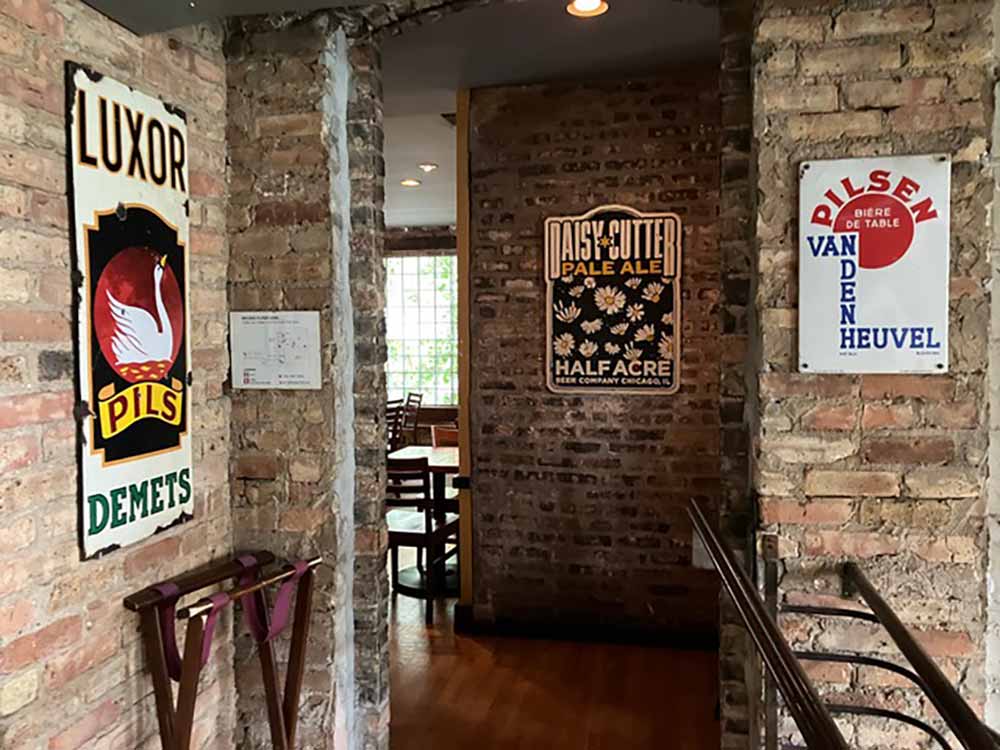
Photography courtesy of Michael Roper | Hopleaf
One of the parts of Daisy Cutter that Magliaro is most proud of is how the beer has transcended the liquid in the can, especially in Chicago.
“It’s yours, too, Chicago,” he says, “ just as much as ours.”
He adds, “We made it and continue to make it and care for it, but it’s Chicago’s beer.”
Magliaro likens Half Acre’s role to a utility company. “Someone has to keep the lights on!” he says, noting that brewing Daisy Cutter has almost been and will continue to be “a civic responsibility.”
Think of Chicago today and, despite the over 200 breweries now within the city, Roper says he still considers Daisy Cutter one of the top two or three beers that define Chicago craft beer.
Why Daisy Cutter Will Never Push Daisies
Whenever Magliaro cracks open a Daisy Cutter in a serene, contemplative setting, he says, “I can only feel very fortunate.”
This beer grew up with Half Acre, helping Half Acre grow—those two statements aren’t mutually exclusive.
A true forever pale ale, Daisy Cutter has become as much a part of the cultural fabric of Chicago as hot dogs with sport peppers and a poppy seed bun.
Yes, we said it. And we’re not the only ones.
“The beer became an institution,” says Roper. “It became a legacy brand that hopefully will continue to have legs.”
And to clarify, by legs, Roper pulled up a number in the hundreds. “I don’t know if we’re going to be drinking Daisy Cutter five hundred years from now (and I won’t be here anyway!), but I think it’s a brand that will be,” he says. “[Daisy Cutter] will find its place in the pantheon of craft beer for a long time to come.”
For Magliaro it all comes back to those stepping up to the bar and ordering a “Daisy.” He hopes that people turning twenty-one today find their way to it and have their own version of excitement. As much as people who have been drinking Daisy Cutter for fifteen years continue to love it.
While there is “no rocket ship any longer, I think it’s going to stay in orbit,” says Magliaro. “And I think that’s wonderful, that is absolutely wonderful.”

